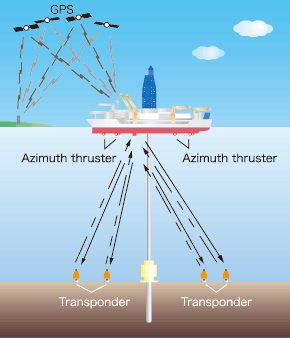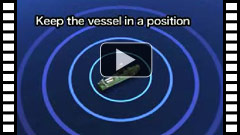
Maintaining a fixed position is an essential requirement for drilling the ocean floor from a drilling vessel. During drilling operations, CHIKYU is connected to the ocean floor by a metal pipe, and any drift in the vessel’s position could cause a major accident. Thanks to its dynamic positioning system, CHIKYU is able to maintain its position on the ocean, despite winds blowing from all directions, crashing waves, and swirling tides. We take a closer look at the system and the advanced technology that makes it possible.
(Published in March 2012)
 |
Interviewee Yasuyuki Yamazaki Engineer Engineering Group, Operations Department Center for Deep Earth Exploration (CDEX) |
Technology to Hold the Vessel in Place

An azimuth thruster measuring approximately four meters in diameter, with an output of 4,200 kW. The three thrusters at the bow and one at the center of the stern are retractable, and in shallow water only the two at the stern are used for navigating.

A global positioning system (GPS) constantly checks the vessel’s position, and the vessel is maintained constantly in a fixed position by seven thrusters (six azimuth thrusters and one tunnel thruster) that can rotate through 360 degrees to ensure that the vessel is not shifted out of position by wind or waves.
There are two ways a ship can maintain its position on the surface of the ocean, where it is constantly subjected to the forces of wind, waves, and currents. One is for the ship to be fastened in position using an anchor or other mooring device. This way, the ship is prevented from moving by being physically fixed in position. The other method is to adjust the ship’s position using thrusters like huge propellers attached to the bottom of the ship. If the wind is blowing from south to north, for example, the ship can be kept in the same position by balancing the northward force of the wind with an equal force propelling the ship from north to south.
CHIKYU’s dynamic positioning system (DPS) operates according to the second of these two principles. DPS technology is widely used in drilling vessels that extract resources from the seabed, but because the effects of external forces on the vessel vary according to the shape of the bow and the bottom of its hull, CHIKYU uses a specially developed system.
“The DPS automatically calculates such factors as the size and direction of external forces and the degree of shift from the vessel’s intended location, and controls the thrusters to counterbalance the effects of these forces,” explains Yasuyuki Yamazaki of the Center for Deep Earth Exploration (CDEX).
Six azimuth thrusters are attached to the bottom of CHIKYU—three at the bow and three at the stern—as well as a single side thruster at the bow. Each thruster is powered by electricity from a generator.
The azimuth thrusters measure about 4 meters in diameter and can be rotated through 360º in a horizontal direction. CHIKYU’s DPS automatically controls the direction of the thrusters to maintain the boat in the assigned position and orientation while minimizing the total electricity consumption of the thrusters. CHIKYU uses all its thrusters when maintaining position with the DPS and two stern thrusters alone for tasks such as changing location within a bay. The side thrusters are mainly used for moving in port, but are also used for maintaining position with the DPS.
“If the DPS broke down, the vessel would no longer be able to maintain its position or move to its intended destination,” says Yamazaki. “If that happened during submarine drilling, it could cause a major accident. The DPS has doubled and redoubled safety measures in place to ensure that functionality is maintained even if some of the equipment fails. The ship can still be controlled even if one of the thrusters breaks down.”
- |1|
- 2|


